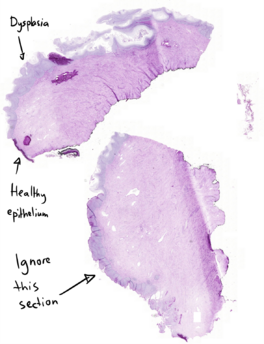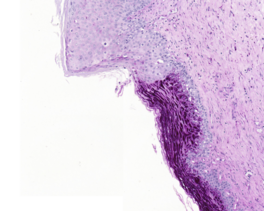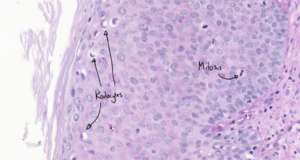34. Cervical intraepithelial neoplasia CIN III: Difference between revisions
No edit summary |
No edit summary |
||
| Line 11: | Line 11: | ||
'''Theory''': The normal epithelium here is the PAS-positive epithelium. The PAS positivity comes from the large amount of glycogen in the epithelial cells. Because the epithelium is stratified squamous and not columnar we know this section is from the exocervix. | '''Theory''': The normal epithelium here is the PAS-positive epithelium. The PAS positivity comes from the large amount of glycogen in the epithelial cells. Because the epithelium is stratified squamous and not columnar we know this section is from the exocervix. | ||
The PAS-negative epithelium has undergone dysplasia. These cells have lost their maturation and orientation, and some undergo mitosis. The loss of maturation and orientation has caused them to not produce glycogen like healthy cells do, which makes them PAS-negative. They are pleomorphic. They’re larger than normal epithelial cells, and don’t have the same shape as the healthy cells anymore. | The PAS-negative epithelium has undergone dysplasia. These cells have lost their maturation and orientation, and some undergo mitosis. The loss of maturation and orientation has caused them to not produce glycogen like healthy cells do, which makes them PAS-negative. They are also pleomorphic. They’re larger than normal epithelial cells, and don’t have the same shape as the healthy cells anymore. | ||
The cells with the perinuclear halo and irregular nuclei are called koilocytes, which are a sign of HPV infection. The presence of these cells is called koilocytosis or koilocytic atypia.[[File:CIN III pleiomorphism.png|thumb|Note also that the cells are pleiomorphic.|left]] | |||
This dysplasia is part of a condition called cervical intraepithelial neoplasia | This dysplasia is part of a condition called cervical intraepithelial neoplasia (CIN). This condition has three degrees of severity: CIN I – Dysplasia in only lower 1/3 of epithelium, CIN II – Dysplasia in lower 2/3 of epithelium, and CIN III – Dysplasia in the whole epithelium. | ||
CIN is a precancerous lesion for cervical cancer. CIN III is the closest to becoming cancer while CIN I is the earliest stage. However, not all CIN III lesions become cancer – only 10% of them become cancerous. Because dysplasia is in the whole width of the epithelium in this slide it is classified as CIN III. | CIN is a precancerous lesion for cervical cancer. CIN III is the closest to becoming cancer while CIN I is the earliest stage. However, not all CIN III lesions become cancer – only 10% of them become cancerous. Because dysplasia is in the whole width of the epithelium in this slide it is classified as CIN III. | ||
[[Category:Pathology 1 - Histopathology slides]] | [[Category:Pathology 1 - Histopathology slides]] | ||
Revision as of 12:13, 5 July 2024

Staining: PAS-H
Organ: Cervix
Description: We can see two sections of a cervix. The top one is the best, so we’ll go with that. On the bottom left corner can we see a very PAS-positive area. Upon closer inspection can we see that the PAS positive cells are stratified squamous cells. The other epithelium found in this section isn’t PAS-positive. This epithelial layer is also much thicker than the other.
The PAS-negative epithelium contains pleomorphic cells (they have different shapes and sizes). These cells are larger than the PAS-positive cells as well. We can also see some cells undergoing mitosis here. A special cell type with a white “ring” around an irregular nucleus can be seen.
Diagnosis: Cervical intraepithelial neoplasia CIN III

Causes: Human papilloma virus (HPV) infection
Theory: The normal epithelium here is the PAS-positive epithelium. The PAS positivity comes from the large amount of glycogen in the epithelial cells. Because the epithelium is stratified squamous and not columnar we know this section is from the exocervix.
The PAS-negative epithelium has undergone dysplasia. These cells have lost their maturation and orientation, and some undergo mitosis. The loss of maturation and orientation has caused them to not produce glycogen like healthy cells do, which makes them PAS-negative. They are also pleomorphic. They’re larger than normal epithelial cells, and don’t have the same shape as the healthy cells anymore.
The cells with the perinuclear halo and irregular nuclei are called koilocytes, which are a sign of HPV infection. The presence of these cells is called koilocytosis or koilocytic atypia.

This dysplasia is part of a condition called cervical intraepithelial neoplasia (CIN). This condition has three degrees of severity: CIN I – Dysplasia in only lower 1/3 of epithelium, CIN II – Dysplasia in lower 2/3 of epithelium, and CIN III – Dysplasia in the whole epithelium.
CIN is a precancerous lesion for cervical cancer. CIN III is the closest to becoming cancer while CIN I is the earliest stage. However, not all CIN III lesions become cancer – only 10% of them become cancerous. Because dysplasia is in the whole width of the epithelium in this slide it is classified as CIN III.
